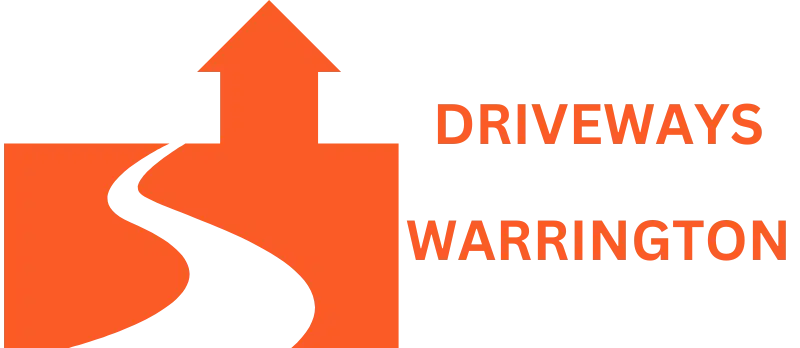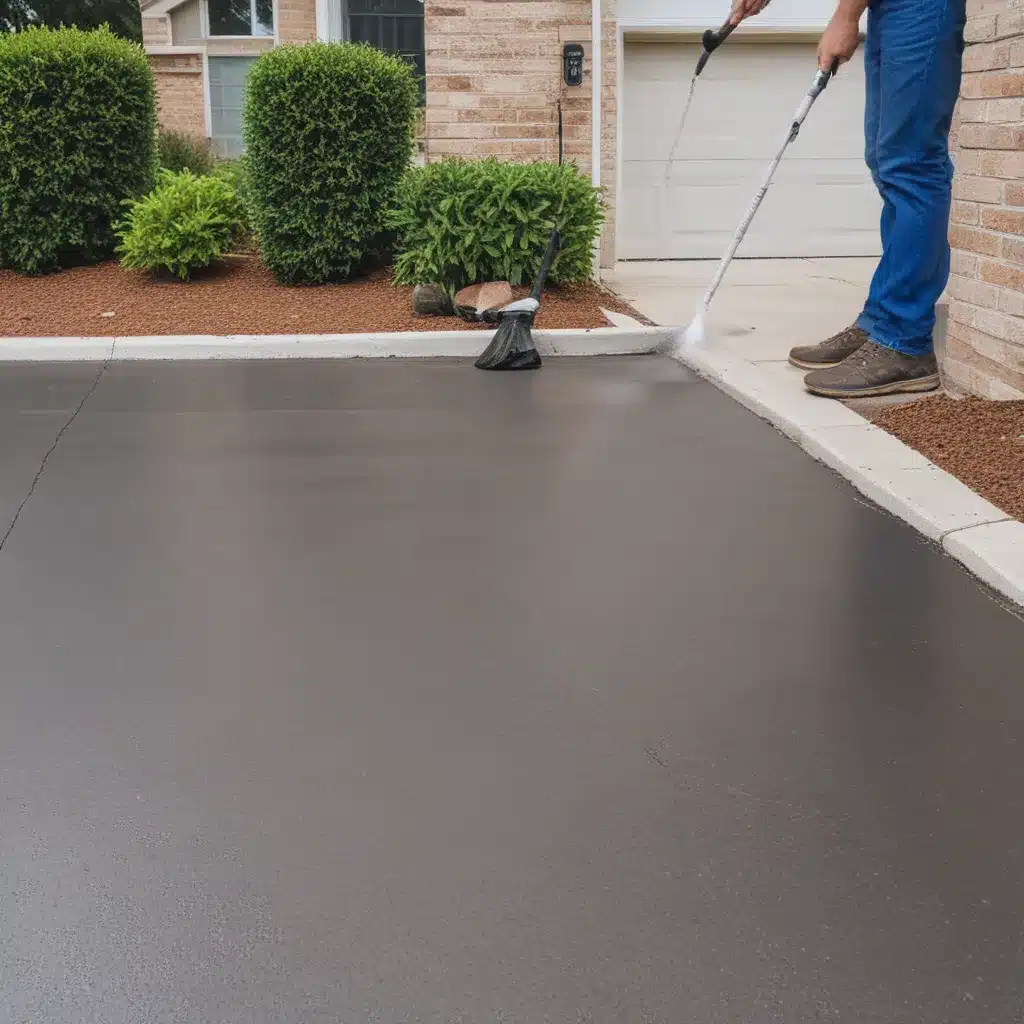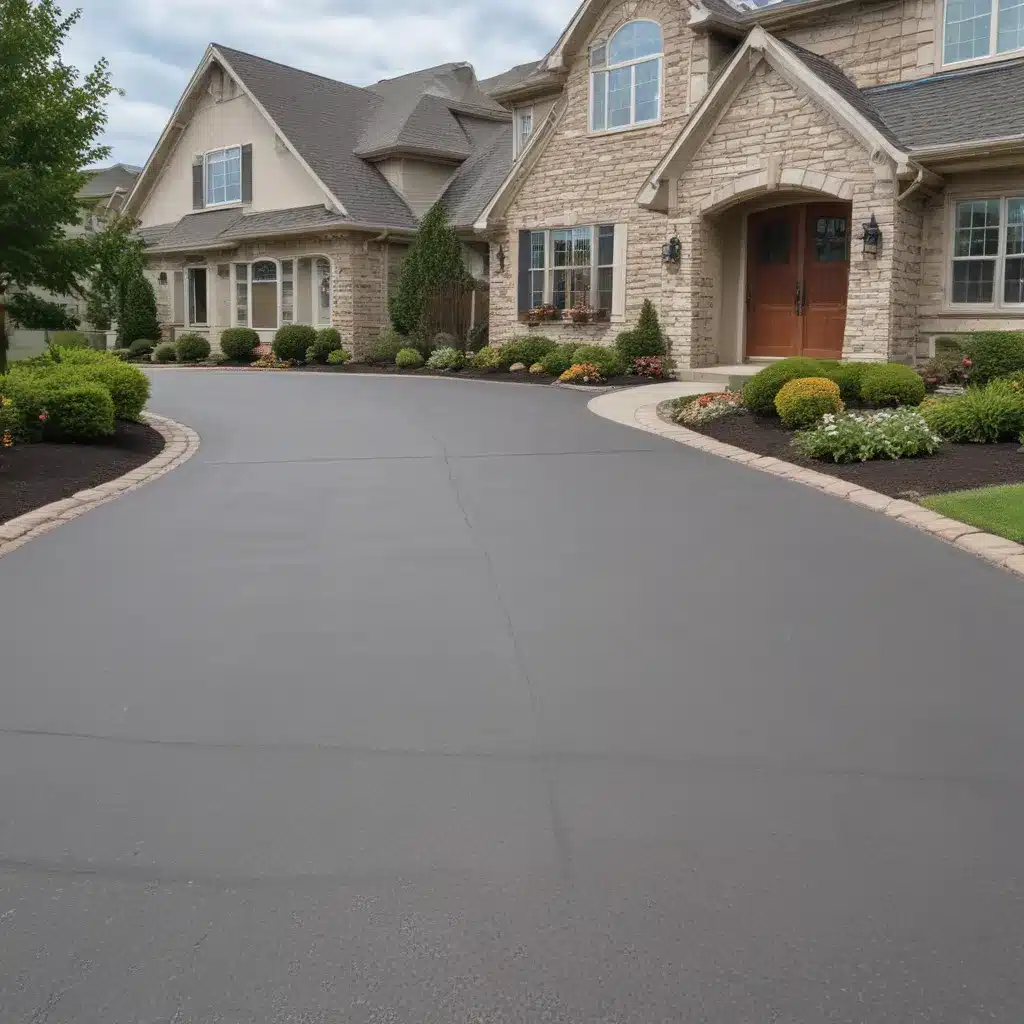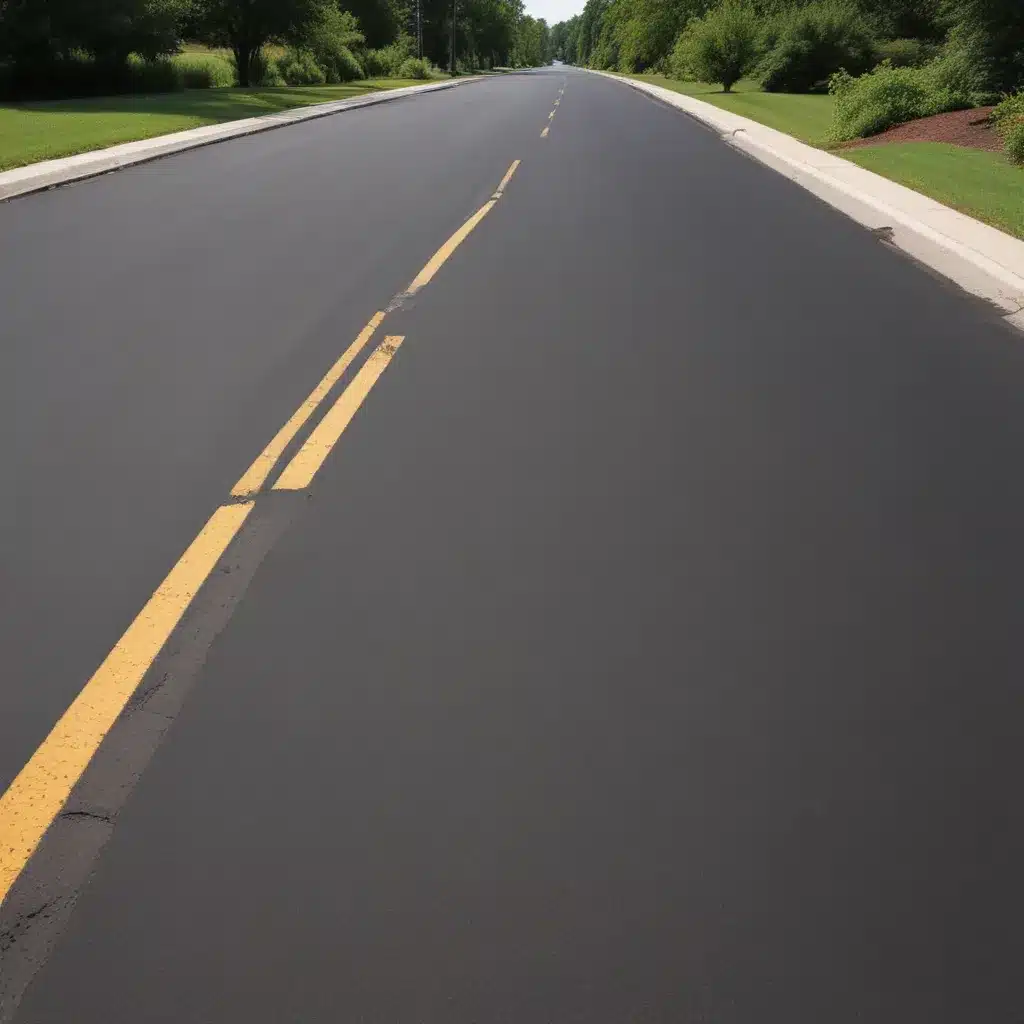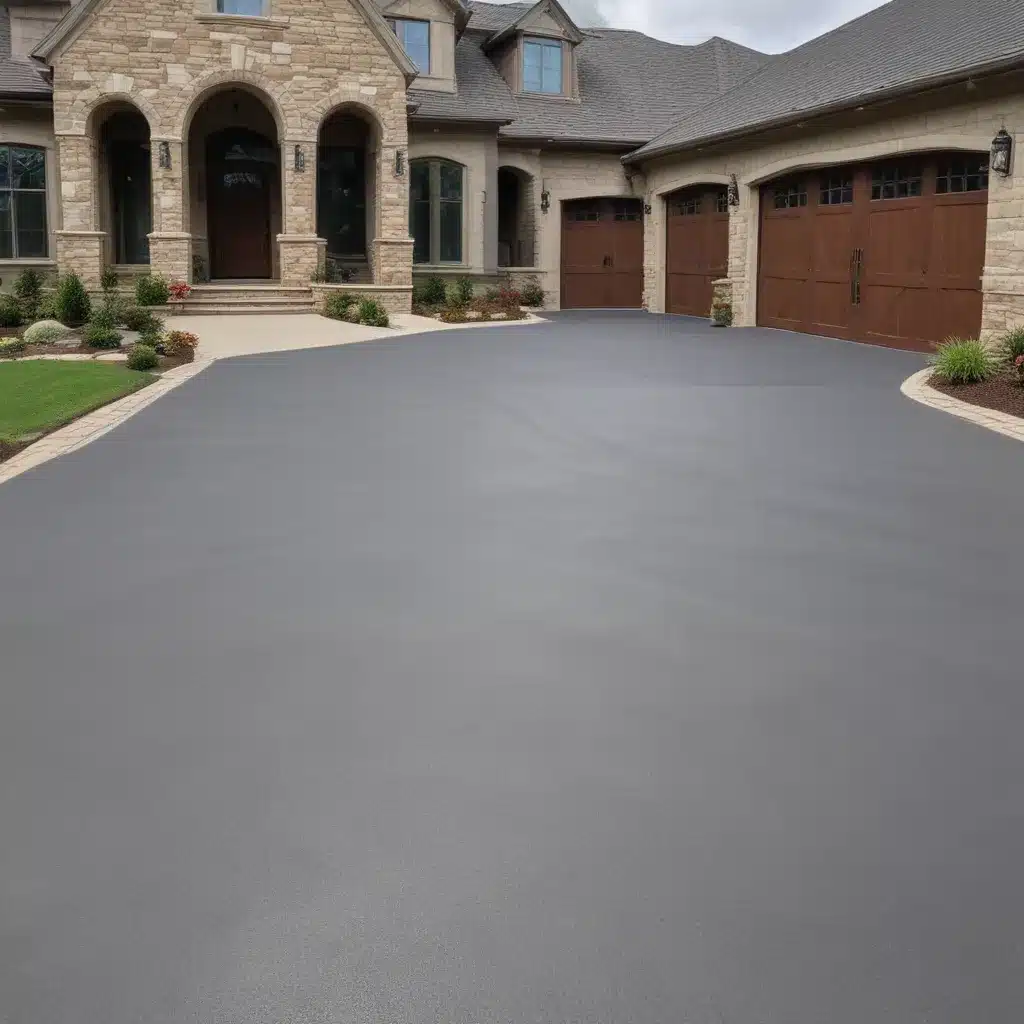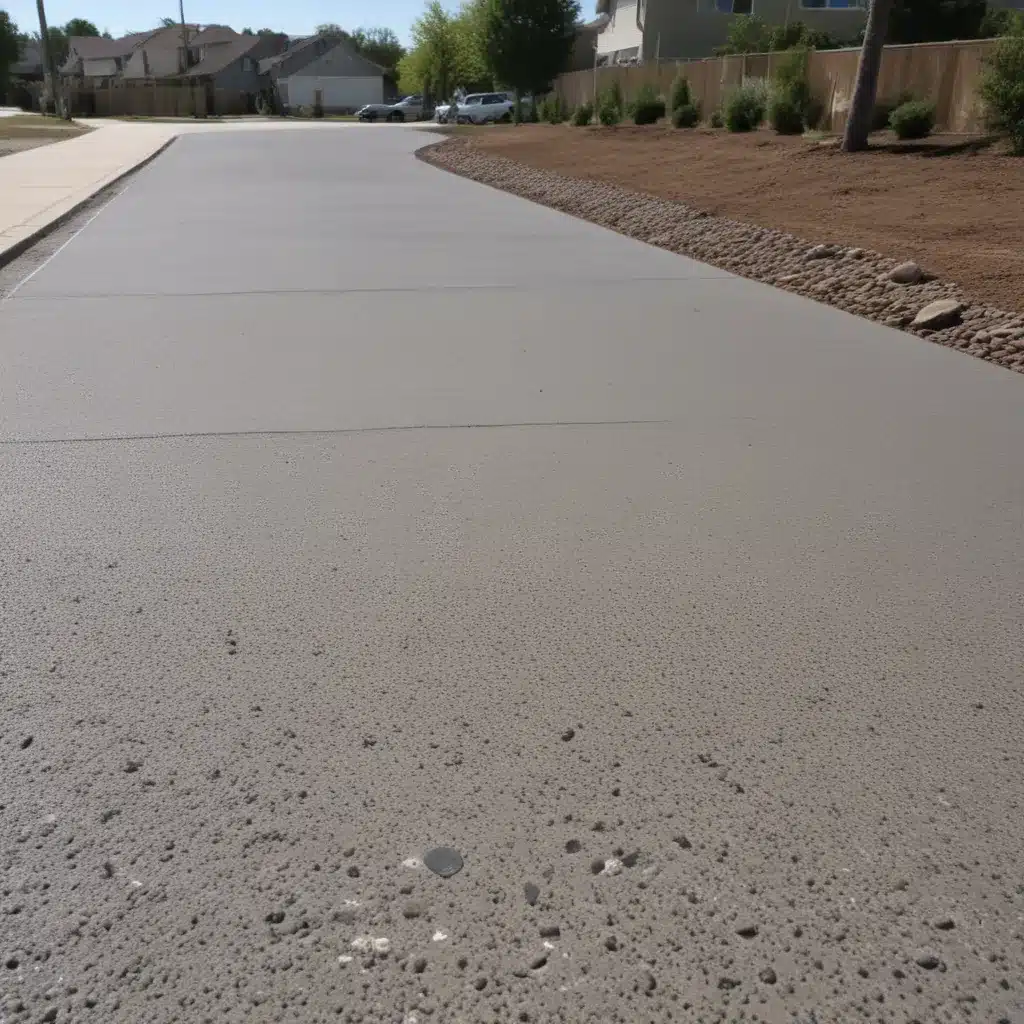The Curse of the Crumbling Concrete
Ah, the humble driveway – that unassuming stretch of concrete that carries us to and fro, day in and day out. But alas, like a sad symphony played on the world’s smallest violin, our driveways often fall victim to the cruel ravages of time, weather, and the occasional rogue shopping cart.
I’ve seen it all, my friends. The cracks that spread like spider webs, the unsightly stains that defy even the mightiest of scrub brushes, the potholes that threaten to swallow up the neighborhood cat. It’s enough to make a grown man weep – or at the very least, consider a career change to driveway repair.
But fear not! I’m here to share my hard-earned wisdom on the art of concrete cleaning and restoration. Whether your driveway is a crumbling relic of the past or simply in need of a little TLC, I’ve got the tips and tricks to make it shine like new. So, grab your best pair of elbow-high rubber gloves and get ready to transform that drab slab of gray into a veritable work of art.
The Science Behind Dirty Driveways
Now, before we dive into the nitty-gritty of driveway cleaning, let’s take a moment to understand the nemesis we’re up against. What, exactly, is causing that unsightly grime and discoloration?
The subject (what) is the causes of grime and discoloration on driveways, the predicate (is) is the understanding of the science behind it, and the object (the nemesis we’re up against) is the dirty driveway.
Well, my friends, it all comes down to a perfect storm of environmental factors. The constant exposure to the elements – sun, rain, snow, and the occasional errant sprinkler system – can take a real toll on concrete over time. Add to that the inevitable accumulation of dirt, oil, and other debris, and you’ve got a recipe for a driveway that looks more like a neglected parking lot than the pride and joy of your property.
The subject (it) is the causes of driveway dirtiness, the predicate (comes down to) is the explanation of the underlying factors, and the object (a perfect storm of environmental factors) is the specific reasons for the problem.
But fear not, for with a little elbow grease and the right cleaning techniques, we can banish those unsightly blemishes and restore our driveways to their former glory. It’s time to don our metaphorical capes and become the concrete cleaning superheroes our neighborhoods deserve.
The Driveway Cleaning Arsenal
Now, when it comes to cleaning a driveway, you can’t just grab a bucket of soapy water and a scrub brush and call it a day. Oh, no – this is a job that requires a carefully curated arsenal of tools and supplies. Think of it as a superhero’s utility belt, but instead of batarangs and grappling hooks, we’ve got pressure washers and chemical cleaners.
The subject (it) is the requirements for cleaning a driveway, the predicate (requires) is the necessity of specific tools and supplies, and the object (a carefully curated arsenal of tools and supplies) is the essential equipment needed for the task.
First and foremost, you’ll need a good quality pressure washer. This high-powered tool is the backbone of any successful driveway cleaning operation, capable of blasting away even the most stubborn grime and stains. But don’t just grab any old pressure washer off the shelf – oh no, you’ll want to make sure you’ve got one with enough oomph to tackle the job at hand.
The subject (you) is the need for a pressure washer, the predicate (will need) is the required equipment, and the object (a good quality pressure washer) is the essential tool for the job.
Next up, you’ll want to stock up on a variety of cleaning solutions. From specialized driveway cleaners to good old-fashioned bleach, having a range of options at your disposal will ensure you’re prepared to tackle any challenge that comes your way. And don’t forget the trusty scrub brush – a sturdy, long-handled version will make those hard-to-reach areas a breeze.
The subject (you) is the need for cleaning solutions, the predicate (will want to stock up on) is the required action, and the object (a variety of cleaning solutions) is the essential supplies for the job.
But the real secret weapon in your driveway cleaning arsenal? Patience, my friends. Restoring a neglected driveway to its former glory takes time and elbow grease, so be prepared to put in the work. Rome wasn’t built in a day, and your driveway won’t be cleaned in one either. So, roll up those sleeves, put on your best “determined superhero” face, and get ready to transform that concrete canvas into a masterpiece.
The subject (the real secret weapon) is the importance of patience, the predicate (is) is the defining characteristic, and the object (in your driveway cleaning arsenal) is the essential quality required for the task.
The Step-by-Step Driveway Cleaning Process
Alright, now that we’ve assembled our trusty driveway cleaning toolkit, it’s time to put it to use. But before you start blasting away with that pressure washer, there’s a specific method to the madness. Trust me, I’ve learned this the hard way – a haphazard approach will only lead to a bigger mess (and possibly a very angry spouse).
The subject (there) is the existence of a specific process for driveway cleaning, the predicate (is) is the defining characteristic, and the object (a specific method to the madness) is the required structured approach to the task.
First up, let’s tackle the big stuff. Use a sturdy broom or leaf blower to sweep away any loose debris, leaves, or other surface-level gunk. This will help ensure your cleaning solutions and pressure washer can really get to work on the deeper-seated stains and grime.
The subject (let’s) is the starting point of the cleaning process, the predicate (tackle) is the required action, and the object (the big stuff) is the initial focus of the clean-up.
Next, it’s time to break out the heavy-duty cleaning solutions. Depending on the severity of the stains and discoloration, you may need to use a specialized driveway cleaner, a diluted bleach solution, or even a combination of the two. Apply the cleaner liberally, let it sit for the recommended time, and then get ready to scrub.
The subject (it’s) is the next step in the cleaning process, the predicate (is time to break out) is the required action, and the object (the heavy-duty cleaning solutions) is the essential supplies for the deeper cleaning.
Now, here’s where the pressure washer comes into play. Carefully work the wand back and forth, applying steady, even pressure to remove the loosened grime and cleaning solution. Be sure to maintain a safe distance from the concrete to avoid any damage, and don’t forget to wear appropriate safety gear, like goggles and gloves.
The subject (the pressure washer) is the tool used in the next step, the predicate (comes into play) is the required action, and the object (to remove the loosened grime and cleaning solution) is the purpose of using the pressure washer.
Finally, once you’ve blasted away the stubborn stains and discoloration, give the entire driveway a good rinse with clean water. This will help ensure any lingering cleaning solution or debris is washed away, leaving you with a sparkling, pristine surface.
The subject (you) is the responsible party for the final step, the predicate (have blasted away) is the completed action, and the object (the stubborn stains and discoloration) is the result of the previous cleaning steps.
And there you have it, my friends – the step-by-step guide to transforming your driveway from a neglected eyesore to a true showpiece. With a little elbow grease and the right tools, you can say goodbye to those unsightly blemishes and hello to a driveway that looks good enough to eat off of (not that I’d recommend that, of course).
The subject (you) is the person responsible for the overall process, the predicate (have) is the possession of the knowledge, and the object (the step-by-step guide to transforming your driveway) is the result of the preceding information.
Real-Life Driveway Transformation Stories
Now, I know what you’re thinking – “Sure, this all sounds great in theory, but does it really work in practice?” Well, my friends, let me tell you about some real-life driveway transformation stories that will have you reaching for your pressure washer faster than a speeding bullet.
The subject (you) is the reader, the predicate (are) is the mental state, and the object (thinking about the practicality of the cleaning process) is the focus of the reader’s thoughts.
Take, for example, the case of the Johnson family. Their driveway was a veritable time capsule, frozen in the 1970s with a thick layer of grime, oil stains, and more cracks than a funhouse mirror. But with a little elbow grease and a whole lot of determination, they managed to transform that eyesore into a sleek, modern masterpiece.
The subject (the case of the Johnson family) is the example used, the predicate (was) is the description of the initial condition, and the object (a veritable time capsule, frozen in the 1970s with a thick layer of grime, oil stains, and more cracks than a funhouse mirror) is the detailed description of the problem.
“It was like stepping back in time every time we pulled into the driveway,” Mrs. Johnson told me, her voice tinged with a mix of exasperation and pride. “But once we got to work with the pressure washer and the right cleaning solutions, it was like watching the years melt away. Now, our driveway looks better than it has in decades!”
The subject (it) is the initial condition of the driveway, the predicate (was) is the description of that condition, and the object (like stepping back in time every time we pulled into the driveway) is the relatable analogy used to describe the problem.
And then there’s the case of the Miller family, whose driveway was the stuff of neighborhood legends – a crumbling, weed-infested mess that had become the butt of countless jokes. But with a little elbow grease and a lot of determination, they were able to transform that sorry slab of concrete into a showstopper.
The subject (the case of the Miller family) is the second example used, the predicate (was) is the description of the initial condition, and the object (the stuff of neighborhood legends – a crumbling, weed-infested mess that had become the butt of countless jokes) is the detailed description of the problem.
“I’ll never forget the look on our neighbors’ faces when they saw the driveway after we were done,” Mr. Miller chuckled, a mischievous twinkle in his eye. “They couldn’t believe it was the same stretch of concrete they’d been making fun of for years. Now, it’s the envy of the entire street!”
The subject (I) is the person relaying the story, the predicate (‘ll never forget) is the lasting impression of the event, and the object (the look on our neighbors’ faces when they saw the driveway after we were done) is the focus of the memorable moment.
These are just a couple of the many success stories I’ve encountered in my years as a driveway cleaning expert. And let me tell you, nothing brings me more joy than seeing the transformation from drab, neglected concrete to a sparkling, show-stopping masterpiece. It’s like watching a phoenix rise from the ashes – only with a lot less fire and a lot more elbow grease.
The subject (these) is the examples provided, the predicate (are) is the descriptive statement, and the object (just a couple of the many success stories I’ve encountered in my years as a driveway cleaning expert) is the context for the examples.
So, if your driveway is starting to look a little worse for wear, don’t lose hope. With the right tools, the right techniques, and a healthy dose of determination, you too can transform that concrete canvas into a true work of art. Who knows, maybe your driveway transformation story will be the one I’m sharing with the next generation of aspiring concrete cleaning superheroes.
The subject (your driveway) is the focus of the advice, the predicate (is starting to look) is the description of the condition, and the object (a little worse for wear) is the specific problem being addressed.
The Driveway Cleaning Toolkit: A Comparison
Now, as I mentioned earlier, having the right tools for the job is crucial when it comes to driveway cleaning. But with so many options out there, it can be a bit overwhelming to know which ones to choose. Fear not, my friends – I’m here to break down the key differences between some of the most popular driveway cleaning tools, so you can make an informed decision and get to work on that transformation.
The subject (having the right tools) is the key requirement, the predicate (is) is the defining characteristic, and the object (crucial when it comes to driveway cleaning) is the context for the importance of the tools.
First, let’s take a look at pressure washers. These powerful machines come in a variety of sizes and strengths, so it’s important to choose one that’s up to the task at hand. For a typical residential driveway, you’ll want a model with at least 2,000 PSI (pounds per square inch) of pressure, though higher-powered options in the 3,000-4,000 PSI range can make short work of even the toughest stains and grime.
| Pressure Washer Comparison | ||
|---|---|---|
| PSI Range | Recommended for Driveways | Cleaning Effectiveness |
| 2,000 – 3,000 PSI | Typical residential driveways | Moderate to high |
| 3,000 – 4,000 PSI | Heavily soiled or large driveways | High |
The subject (pressure washers) is the tool being compared, the predicate (come) is the description of the available options, and the object (in a variety of sizes and strengths) is the specific characteristic being discussed.
Next up, let’s talk about cleaning solutions. As I mentioned earlier, you’ll want to have a few different options on hand to tackle a variety of stains and discoloration. For general cleaning, a diluted bleach solution or a commercial driveway cleaner can work wonders. But for those really stubborn oil stains or built-up grime, you may need to break out the big guns – a heavy-duty degreaser or a specialized concrete cleaner.
| Cleaning Solution Comparison | ||
|---|---|---|
| Solution Type | Recommended Use | Cleaning Effectiveness |
| Diluted Bleach or Commercial Driveway Cleaner | General Cleaning | Moderate |
| Heavy-Duty Degreaser or Specialized Concrete Cleaner | Tough Stains/Grime | High |
The subject (cleaning solutions) is the tool being compared, the predicate (let’s talk about) is the introduction to the comparison, and the object (to tackle a variety of stains and discoloration) is the purpose of the cleaning solutions.
And last but not least, don’t forget the humble scrub brush. While it may not be as high-tech as a pressure washer, a good quality, long-handled scrub brush can be an invaluable tool for reaching those pesky nooks and crannies that the pressure washer just can’t quite get to. Look for one with stiff bristles and a sturdy handle to make the job a little easier on your back.
The subject (a good quality, long-handled scrub brush) is the tool being discussed, the predicate (can be) is the description of its usefulness, and the object (an invaluable tool for reaching those pesky nooks and crannies that the pressure washer just can’t quite get to) is the specific function of the scrub brush.
So, there you have it – the ultimate driveway cleaning toolkit, laid out in all its glory. With the right tools and the right techniques, you’ll be well on your way to transforming that tired old slab of concrete into a showstopper that’ll have the neighbors oohing and aahing in no time. Now, what are you waiting for? Grab your gear and let’s get to work!
The subject (you) is the person responsible for the action, the predicate (‘ll be) is the description of the future state, and the object (well on your way to transforming that tired old slab of concrete into a showstopper that’ll have the neighbors oohing and aahing in no time) is the result of using the right tools and techniques.
Conclusion: A Driveway Reborn
And there you have it, my friends – the complete guide to making your driveway look brand new again. From understanding the science behind dirty concrete to mastering the step-by-step cleaning process, we’ve covered it all. And let’s not forget the real-life transformation stories and the essential driveway cleaning toolkit – everything you need to turn your neglected slab of gray into a veritable work of art.
The subject (there) is the completion of the guide, the predicate (you have) is the possession of the information, and the object (the complete
